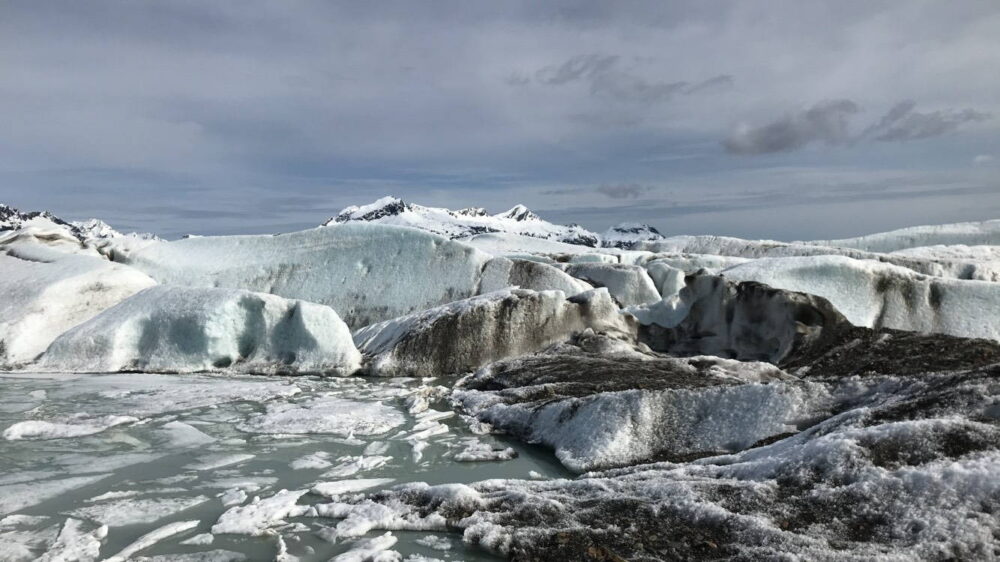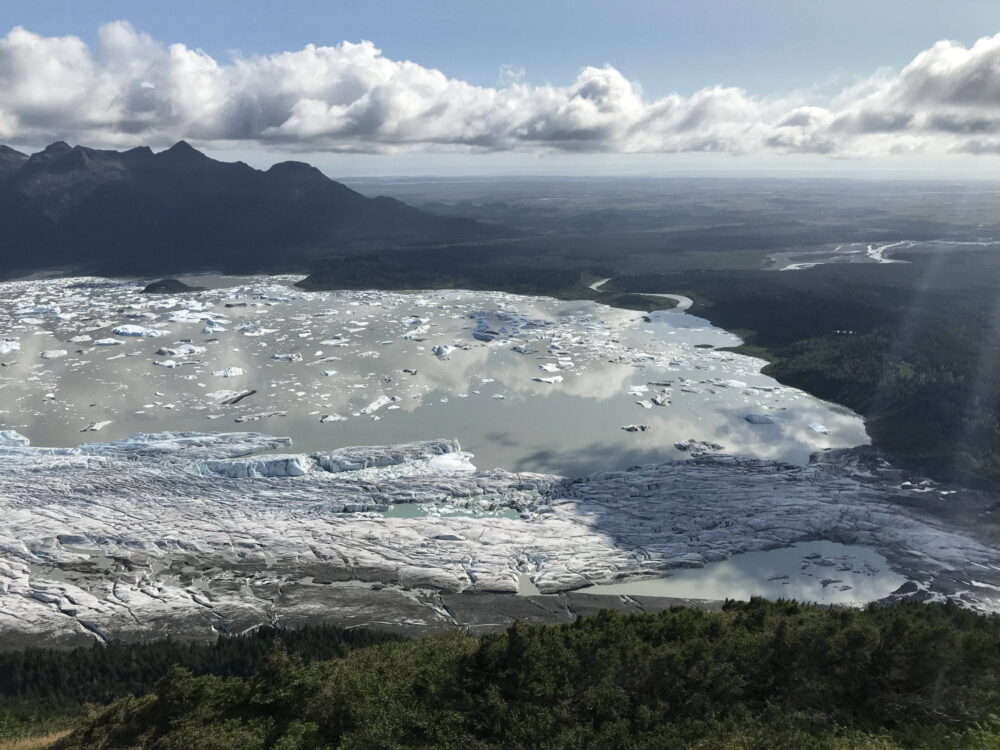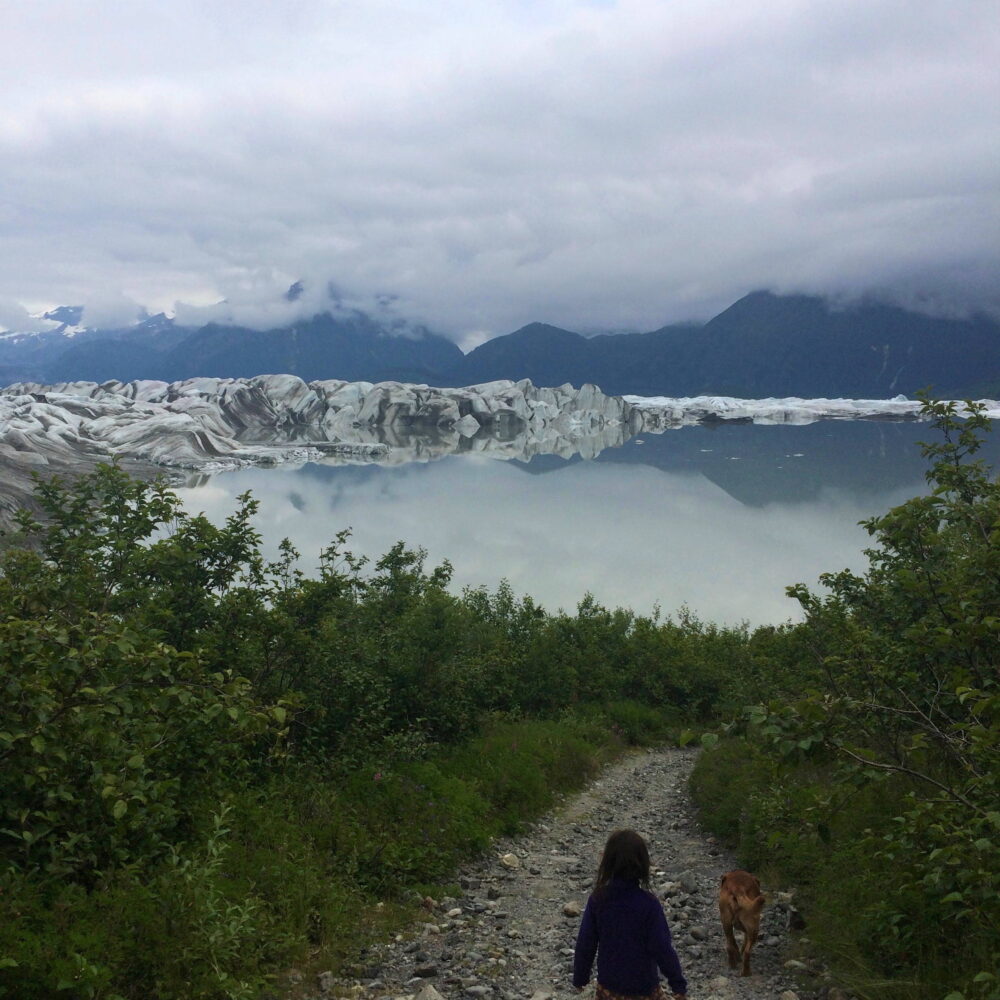Cryogenics

Surfaces move and respond. One (in)forms the other, ice and rock, silt and river, sketching shapes. A dance careful and delicate, scrape and scratch, long and lustful. Glacier moves earth and earth shudders, crumbles a reply.
Glacier remains of ancient age.
The color, feel of fiberglass, insulation
in crosshatches of clothes and arm-hairs.
This glacier itches.
Glacier scratches an itch.
It gleams a heart flutter.
Snow blind, it terrifies.
An ice pick advent
ure. This glacier makes the news.
It makes men, men, men.
We used to drive to the glacier at least once a summer. It was 52 miles from town— gravel road, unpaved, unkempt. As teenagers we would pack into a friend’s truck and hotrod out the road. We drove out to the glacier to smoke weed. To try chew for the first time and get stomach-aches, end up on the bed of a speeding truck, letting the air roll over our bodies in hopes of being cured from the poison we packed in our lips. An occasional straggler from the Sierra Club, maybe Patagonia, touring the glacier would approach us and asked to get smoked out. That tree hugger got high as shit.
We built palette fires near the glacier’s edge and roasted hot dogs and grilled hamburgers with our flannels pulled high around our necks to shield from the glacier air that sighed in our direction. Sometimes we got so baked that we couldn’t get out of the truck, paranoid that the calving glacier would trigger a tidal wave malicious at the sight of us. GERONIMO! white boys called as an icy piece fell from the glacier’s face and plunged into the river below. Other times we pulled guns on the glacier, shot up all our bullets and giggled, laughed, held our bellies, screamed in delight and chaos.
Glacier has a face.
Glacier’s eyes stare
down the barrel of my grandfather’s gun.
Squeeze the trigger.
Give ‘em hell.
Calve baby calve.
Glacier, a puddle.
Glacier, a monsoon,
a tsunami.
Glacier, a plaque,
a siren.
This glacier is General Philip Sheridan Glacier.
General Henry Clark Corbin Glacier.
General William Tecumseh Sherman Glacier.
General Theodor Schwan Glacier.
Historians say: these men are Generals of the Civil War.
These are Generals of the Indian Wars.
Sheridan Glacier was named in 1884 after General Philip Sheridan. Captain William Abercrombie named this glacier after his wartime friend. How much does it cost to be frozen after death? Philip Sheridan, the Civil War General Indian War Criminal is famous for saying: “The only good Indian is a dead Indian.” Some say: it was actually Teddy Roosevelt who said: “The only good Indian is a dead Indian,” but Dee Brown said: Sheridan said it. Bury my heart at Sheridan Glacier.
We brought gangions with us, sat by the glacier and tied knots, knot after knot after knot after not asking anything but that each piece of metal and twine lure something up from the briny deep one gilled mouth at a time. Once we were hungover and searching for a cure, we submerged ourselves in the frigid silty blue river water that kissed the glacier’s face.
Other times we were pensive. Walking the glacier beach looking for good skipping rocks. Building maze designs in the glacier’s boulder garden. Squinting out at the glacier across the slow-moving river between us, wondering what it must be like to travel this land in the cottonwood canoes at the museum, carved by a relative. They say: it’s the last one like it.
And I say: I’m sorry for my arrogance, glacier. I’m sorry for yelling and laughing as the gunshots rained down around you, your blue face, my transgressions alone deserve the consequences of your rapid transition. I hold myself at fault for your shift. I don’t put all the blame on the carbon emissions, the global-conglomerates, though they too are culpable just like the Indian Killers that never met you but live in your name. Please forgive me glacier—I beg you in ways that reveal I have no teacher. I have no guide other than readings by anthropologists who recorded stories told by old native ladies who you know and I never met.
Anthropologists say: A thoughtless remark could have devastating results because according to oral traditions glaciers listen and make moral judgments and punish infractions.
One day, little raven girl was bored. Her father had taken the dogs out hunting, her mother was gathering roots in a place too steep and dangerous for little raven girl.
Her old aunty had fallen asleep. So the small girl sang to her doll that her mother had made for her out of lichen covered spruce bark. She fed her doll dried blueberries, asked her doll if she would like to dance but the doll did not respond. Little raven girl grew restless; she flung her doll to the ground and crept the short distance from her play place to where she could see the left face of the glacier. A mischief curled the edge of little raven girl’s lips and she said:
HEY, GLACIER!
Just as her doll did not respond, glacier remained unmoved.
HEY, YOU, GLACIER! Little raven girl called more loudly with a frustrated need. GLACIER!!
Glacier turned an ear lovingly to little raven girl, the one who glacier had watched be born and walk and play along glacier’s fringe.
HEY GLACIER, YOUR EYES ARE TOO CLOSE TOGETHER! Little raven girl cried brazenly, hoping to elicit some response.
HEY GLACIER, I CAN SEE YOUR BALD SPOT!
Glacier stared at her and breathed in deeply. Glacier exhaled and surged forward, its body screamed, cracked, and thundered. In its bolt forward it displaced an icy lake and shards of glacier ice daggered down from the sky. Glacier did not stop there: it swamped the little raven girl’s village, rolled over the homes of her people and her little doll. Glacier stopped salmon as they swam, froze fins against fishy bodies. Glacier turned on little raven girl and out of its icy blue slits emerged what she most feared but had never spoken. She saw that her fears had married her most secret desires. Her most murderous ideas had bred with her truest intentions and their offspring came for her.
Anthropologists say: The same glacial advances are documented in geoscience records.
Glacier leaves in its path sediments rich and vital, pollinating a green that coats this valley in lichen—a plant that takes carbon and persuades it into air for breath. Glacier forges a soil that grows cabbages the size of planets, thousands of pounds, weighed every year at the fair.
I say that glacier says: This is where I dance; I melt, to change my form for you. This is where the seals open, generous and giving, during pupping season. Might you share with me this place?
Anthropologists say: Glaciers do not like to be looked at directly in the face. The natives say you must avert your eyes.
Featured image: La’, Eyak, Alaska. Photo by Jimmy Boy.
Jen Rose Smith (Eyak) is a postdoctoral fellow at UC Davis in the department of Native American Studies. In August 2020, she will begin as an assistant professor at the University of Wisconsin–Madison in the Geography Department and American Indian Studies Program. Her research project Indeterminate Natures: Race and Indigeneity in Ice-Geographies foregrounds an analysis of colonialism in relation to ice in Alaska and the Arctic. Her most recent contribution to Edge Effects was “What One Court Case Could Mean for Tribal Sovereignty: A Conversation with Rebecca Nagle.” Website. Twitter. Contact.



